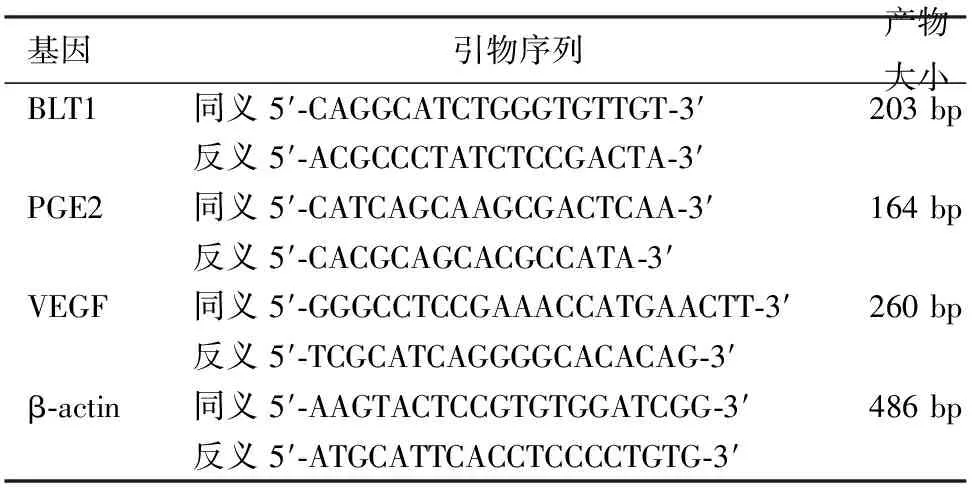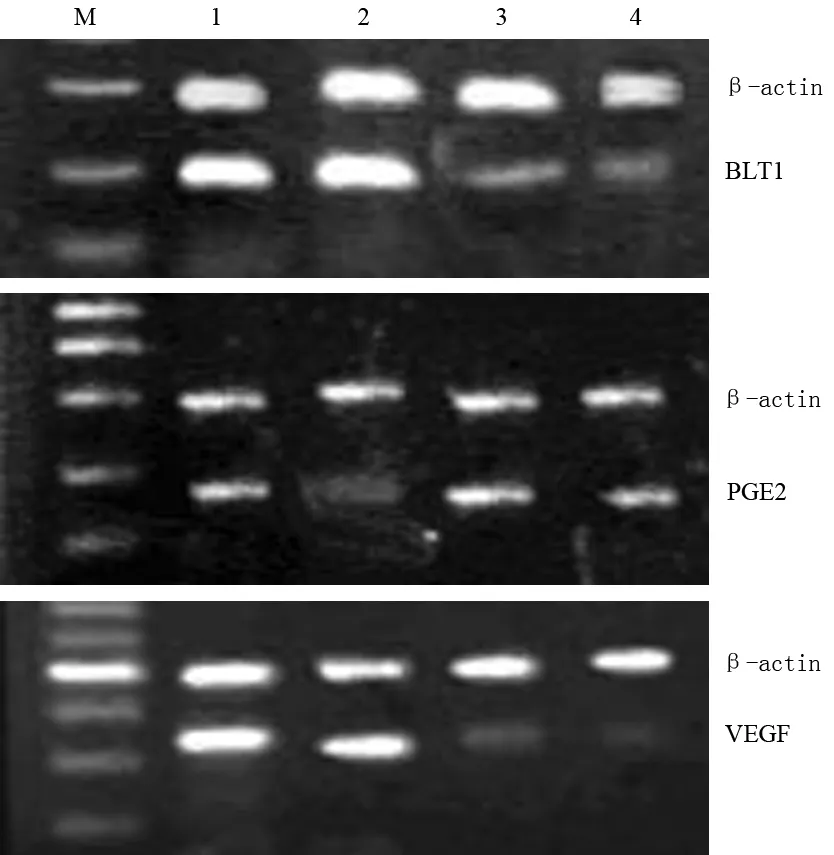MK886和Celecoxib抑制胰腺癌SW1990细胞生长及血管生成的实验研究
周国雄 朱陈 丁晓凌 张海峰 张弘 曹维 强晖 徐正府
·论著·
MK886和Celecoxib抑制胰腺癌SW1990细胞生长及血管生成的实验研究
周国雄 朱陈 丁晓凌 张海峰 张弘 曹维 强晖 徐正府
目的观察5-脂氧合酶拮抗剂MK886、环氧化酶2拮抗剂Celecoxib干预SW1990细胞后对细胞增殖及血管内皮生长因子(VEGF)mRNA表达的影响。方法应用不同浓度的MK886、Celecoxib以及两者联合处理SW1990细胞,采用胆囊收缩素(CCK-8)法检测细胞的增殖, RT-PCR法检测细胞白三烯B4受体1 (BLT1)mRNA、前列腺素2(PGE2) mRNA、VEGF mRNA的表达。结果10 μmol/L MK886或20 mmol/L Celecoxib处理24 h后,SW1990细胞的增殖受到明显抑制(1.80±0.06比1.65±0.10;2.04±0.03比1.86±0.02,P<0.05),且随药物浓度的增加,细胞的增殖抑制更明显。两拮抗剂联合干预12 h后,SW1990细胞的增殖即受到非常明显的抑制(1.72±0.05比1.52±0.05,P<0.01)。Celecoxib处理细胞48 h后,细胞BLT1、VEGF mRNA表达与对照组比较无明显变化,但PGE2 mRNA的表达明显减少(37.50比71.50,P<0.05);MK886或MK886+Celecoxib联合处理细胞后,细胞BLT1、VEGF mRNA表达明显减少(40.30、22.75比126.50,P<0.05),而PGE2 mRNA的表达与对照组比较无明显变化。结论花生四烯酸的两条代谢途径均与胰腺癌的发生及增殖有密切关系,同时抑制两条途径可显著抑制胰腺癌细胞的增殖。
胰腺肿瘤; MK886; Celecoxib; 5-脂氧合酶; 环氧化酶-2
研究显示,花生四烯酸代谢途径与肿瘤的发生、发展有密切关系。花生四烯酸的代谢有两条途径,即环氧化酶(COX)和脂氧合酶(LOX)代谢途径。COX代谢途径的下游产物是前列腺素2(prostaglandin E2,PGE2),LOX催化的代谢终产物为白三烯(leukotrienes, LTs)。Celecoxib是COX2拮抗剂,MK886是特异性5-LOX拮抗剂。5-LOX还可影响血管内皮生长因子,促进肿瘤血管生成。本研究应用MK886和Celecoxib干预人胰腺癌细胞株SW1990,观察其对癌细胞生长及VEGF mRNA表达的影响,探讨抑制胰腺癌细胞增殖更有效的途径。
材料与方法
一、细胞培养
胰腺癌细胞株SW1990购自中国科学院上海生命科学研究所,用含10%新生小牛血清的DMEM培养液常规培养, 3~4 d用胰酶消化,按1∶3传代。
二、细胞增殖检测
采用胆囊收缩素(CCK-8)法。取对数生长期细胞,以1×104个细胞(100 μl)接种于96孔板培养过夜。加入终浓度为10、20、40、80、100、200 μmol/L的MK886(Bimol公司)或10、20、40、80、100 μmol/L的Celecoxib(上海信合化工有限公司)或200 μmol/L MK886+80 μmol/L Celecoxib继续培养6、12、24、48 h。每个剂量组设三个复孔。对照组加含0.01% DMSO培养液。培养后每孔加入CCK-8 10 μl,继续培养2 h。酶标仪测定各孔450 nm处吸光值(A450)。以不加细胞的空白组A450值调零。
三、BLT1、PGE2、VEGF mRNA检测
采用RT-PCR法检测。取不同抑制剂培养48 h组和对照组细胞,抽提总RNA, RT-PCR法检测BLT1、PGE2、VEGF mRNA。引物设计见表1。PCR反应参数:94℃ 5 min,94℃ 30 s、58℃ 45 s、72℃ 55 s,36次循环,最后72℃ 7 min。以目的条带与β-actin条带灰度值比值作为mRNA相对表达量。实验重复3次。
四、统计学处理

表1 PCR引物序列
结 果
一、SW1990细胞增殖的变化
10 μmol/L MK886或20 μmol/L Celecoxib处理24 h后,SW1990细胞的增殖受到明显抑制(P<0.05),且随药物浓度增加,细胞的增殖抑制更明显(图1)。200 μmol/L MK886和80 μmol/L Celecoxib联合干预12 h后,SW1990细胞的增殖即受到非常明显的抑制(P<0.01,图1)。

图1MK886(a)、Celecoxib(b)和两者联合(c)处理后SW1990细胞增殖的变化
二、SW1990细胞BLT1、PGE2、VEGF mRNA表达的变化
胰腺癌SW1990细胞均表达BLT1、PGE2、VEGF mRNA。100μmol/L Celecoxib处理细胞48 h后,细胞BLT1、VEGF mRNA表达与对照组比较无明显变化,但PGE2 mRNA的表达明显减少(37.50比71.50,P<0.05);400 μmol/L MK886或200 μmol/L MK886+80 μmol/L Celecoxib联合处理细胞后,细胞BLT1、VEGF mRNA表达明显减少(40.30、22.75比126.50,P<0.05),而PGE2 mRNA的表达与对照组比较无明显变化(图2)。

图2对照组(1)及Celecoxib(2)、MK886(3)、Celecoxib+MK886(4)处理SW1990细胞后的BLT1、PGE2、VEGF mRNA表达
讨 论
Eberhart等[1]首先报道COX2在结肠癌中的高表达。将COX2拮抗剂和其他抗肿瘤药物联合应用治疗胰腺癌有明显效果[2]。文献报道[3-4],结肠癌、乳腺癌、肺癌、前列腺癌及胰腺癌等细胞株均高表达5-LOX。在胰腺癌组织中,不仅5- LOX表达增加,5-LOX的下游代谢产物LTB4以及受体的表达同样增加,特别是在胰岛周围、导管细胞内以及纤维变性组织中,他们推断LTB4同样能促进胰腺癌细胞的增殖[5-6]。本结果显示,MK886及Celecoxib均呈剂量及时间依赖性抑制SW1990细胞的增殖;两者联合应用具有协同抑制作用。
BLT1是LTB4的高亲和力G-蛋白耦联受体,正常情况下,仅表达于白细胞,在胸腺和脾脏上少量表达。Tong等[6]报道,LTB4受体拮抗剂LY293111在体内外均阻滞胰腺癌细胞增殖。本结果显示,5-LOX拮抗剂MK886抑制SW1990细胞BLT1 mRNA的表达,而不影响PGE2 mRNA表达;COX2拮抗剂Celecoxib抑制SW1990细胞PGE2 mRNA表达,而不影响BLT1 mRNA表达,提示当阻断5-LOX代谢途径时,COX2途径无明显变化。因此5-LOX代谢途径与胰腺癌的发生、发展关系更为密切。
VEGF是刺激肿瘤血管生长的最主要因子。文献[7-8]报道,COX2/PGE2系统在肿瘤血管生成中起重要作用。本结果显示,Celecoxib对VEGF mRNA表达无明显影响,而MK886、MK886和Celecoxib的联合干预则抑制VEGF mRNA的表达。
总之,通过阻断花生四烯酸代谢的两条途径均可抑制胰腺癌SW1990细胞的增殖,其中5-LOX代谢途径可能起主要作用,而同时阻断两条途径能更显著抑制胰腺癌细胞的增殖,为临床胰腺癌的治疗提供新的思路。
[1] Eberhart CE, Coffey RJ, Radhika A, et al. Up-regulation of cyclooxygenase 2gene expression in human colorectal adenomas and adenocarcinomas.Gastroenterology, 1994,107: 1183-1188.
[2] Ferrari V, Valcamonico F, Amoroso V, et al.Gemcitabine plus celecoxib (GECO) in advanced pancreatic cancer: a phase Ⅱ trial. Cancer Chemother Pharmacol,2006,57:185-190.
[3] Hong SH, Avis I, Vos MD, et al. Relationship of arachidonic acid metabolizingenzyme expression in epithelial cancer cell lines to the growth effect of selective biochemicalinhibitors. Cancer Res, 1999, 59: 2223-2228.
[4] Ding XZ, Iversen P, Cluck MW, et al. Lipoxygenase inhibitors abolish proliferation of human pancreatic cancer cells. Biochem Biophys Res Commun,1999,261:218-223.
[5] Hennig R, Ding XZ, Tong WG, et al.5-Lipoxygenase and leukotriene B4 receptor areExpressed in human pancreatic cancers but not in pancreatic ducts in normal tissue. Am J Pathol,2002,161:421-428.
[6] Tong WG,Ding XZ,Hennig R,et al.Leukotriene B4 receptor antagonist Ly293111 inhibits proliferation and induces apoptosis in human pancreatic cancer cells.Clin Cancer Res,2002,8:3232-3242.
[7] Eibl G, Takata Y, Boros LG, et al.Growth stimulation of COX-2-negative pancreatic cancer by a selective COX-2 Inhibitor, Cancer Res, 2005, 65: 982-990.
[8] Amano H, Hayashi I, Endo H, et al. Host prostaglandinE(2)-EP3 signaling regulates tumor-associatedangiogenesis and tumor growth. J Exp Med,2003,197:221-232.
2011-03-22)
(本文编辑:屠振兴)
InhibitoryeffectofMK886andcelecoxibonthegrowthofpancreaticcancercelllineSW1990andangiogenesis
ZHOUGuo-xiong,ZHUChen,DINGXiao-ling,ZHANGHai-feng,ZHANGHong,CAOWei,QiIANGHuai,XUZheng-fu.
DepartmentofGastroeterology,AffiliatedHospitalofNantongUniversity,Nantong226001,China
ZHOUGuo-xiong,Email:zhouguoxiong@medmail.com.cn
ObjectiveTo investigate the effects of two inhibitors of arachidonic acid metabolic pathway (5-cyclooxygenase blockade MK886 and COX 2 blockade celecoxib) on growth and VEGF mRNA expression of human pancreatic cancer cell SW1990.MethodsPancreatic cancer cells SW1990 were cultured with different concentrations of MK886, celecoxib, MK886 and celecoxib, then the cell proliferation was detected by using CCK-8, BLT1 mRNA, PGE2 mRNA and VEGF mRNA expressions were determined by RT-PCR.ResultsAfter 10 μmol/L MK886 or 20 mmol/L celecoxib treatment for 24 h, the growth of SW1990 was greatly suppressed (1.80±0.06vs1.65±0.10, 2.04±0.03vs1.86±0.02,P<0.01), and the growth suppression of SW1990 cells was increased accompanying the raised concentration of MK886 or celecoxib. After both MK886 and celecoxib treatment for 12 h, the growth of SW 1990 cells was much obviously suppressed (1.72±0.05vs1.52±0.05,P<0.01).After celecoxib treatment for 48 h, the BLT1 mRNA, PGE2 mRNA and VEGFmRNA expressions were not significantly changed, but the expressions of PGE2 mRNA were significantly decreased (P<0.05). After MK886 or MK886+celecoxib treatment, the expressions of BLT1 mRNA, VEGF mRNA were significantly decreased (P<0.05), but the expressions of PGE2 mRNA were not significantly changed when compared to control group.ConclusionsTwo metabolic pathways of arachidonic acid have a close relation with occurrence and proliferation of pancreatic cancer, when both of the pathways were blocked, the proliferation of the pancreatic cancer cell was suppressed obviously.
Pancreatic neoplasms; MK886; Celecoxib; 5-Lipoxygenase; Cyclooxygenase
10.3760/cma.j.issn.1674-1935.2011.06.009
江苏省自然科学基金(BK2004049),江苏省重点医学人才基金(RC2007085)
226001 江苏南通,南通大学附属医院消化内科
周国雄,Email:zhouguoxiong@ medmail.com.cn

